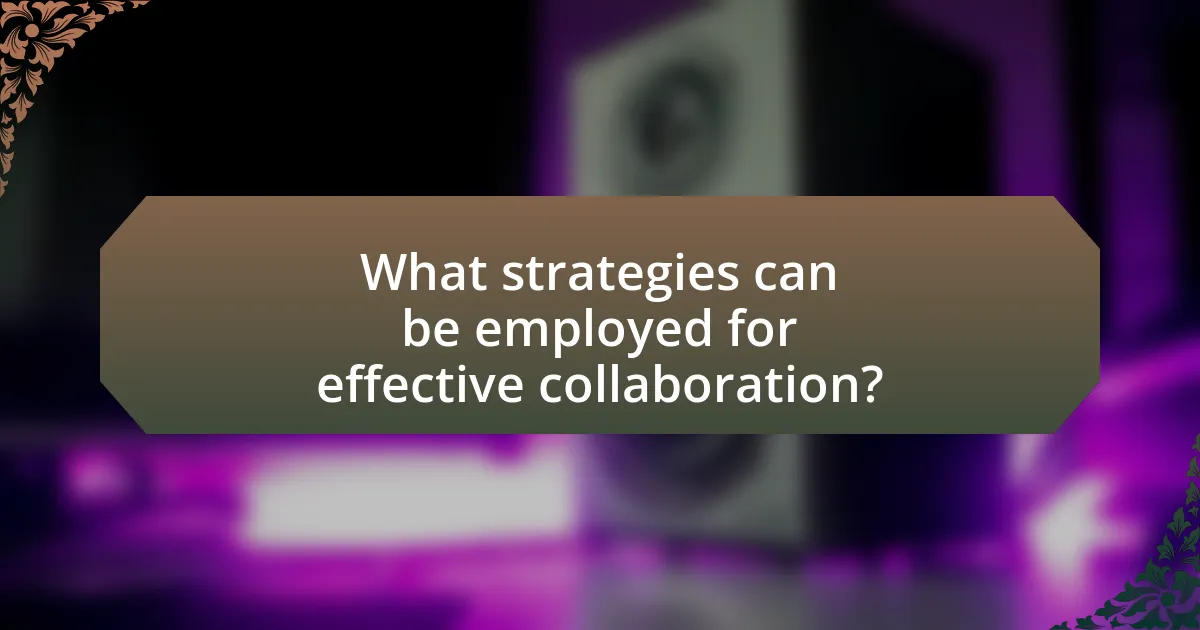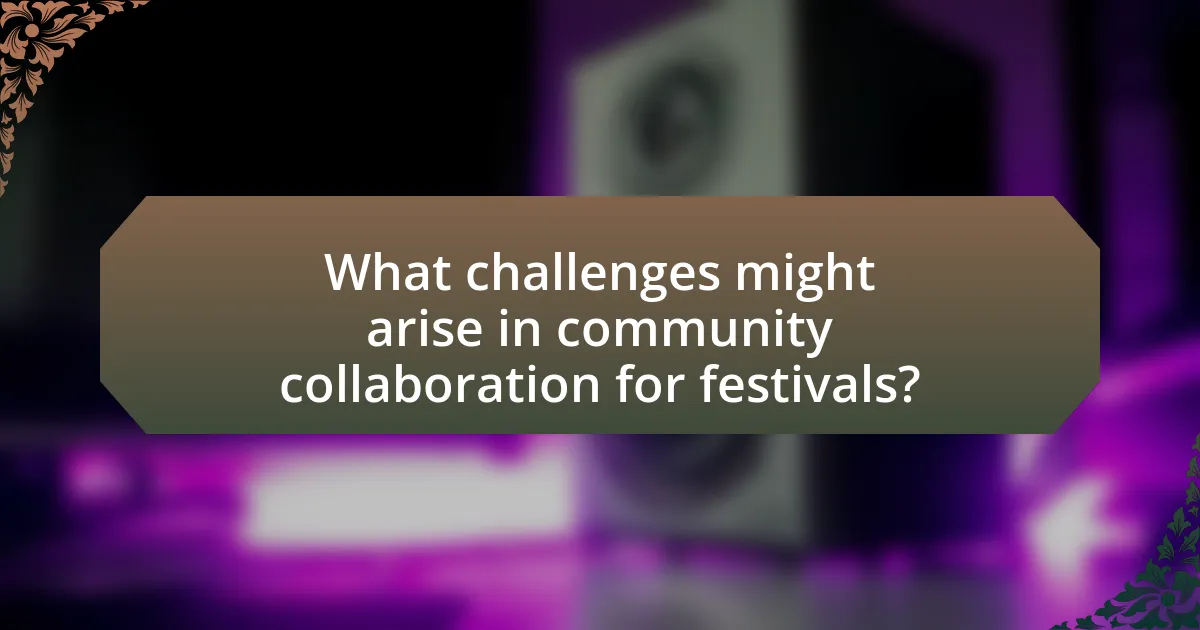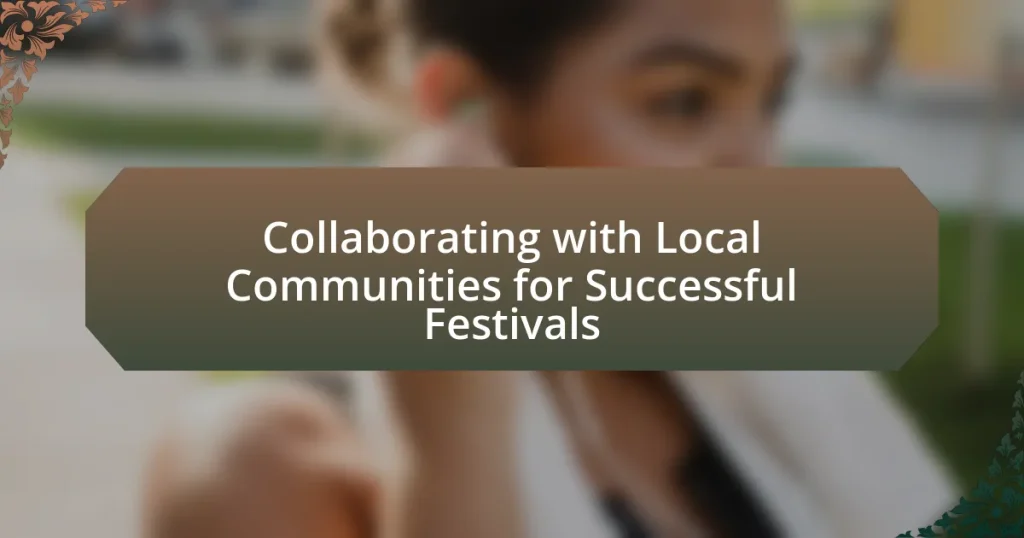Collaborating with local communities is essential for the success of festivals, as it involves engaging residents in the planning, execution, and evaluation processes. This collaboration enhances cultural relevance, increases attendance, and fosters a sense of ownership among community members. Key contributions from local communities include providing local knowledge, mobilizing volunteers, and participating in decision-making, which collectively lead to higher satisfaction rates and economic impact. Effective communication, mutual respect, and shared goals are critical strategies for building strong relationships with local stakeholders, while addressing challenges such as differing priorities and resource allocation is vital for successful collaboration.

What does collaborating with local communities for successful festivals entail?
Collaborating with local communities for successful festivals entails engaging community members in the planning, execution, and evaluation of the event. This collaboration fosters a sense of ownership and ensures that the festival reflects the community’s culture and values. For instance, studies show that festivals that incorporate local traditions and involve residents in decision-making processes see higher attendance and satisfaction rates, as evidenced by the 2019 National Endowment for the Arts report, which highlighted that community involvement enhances cultural relevance and economic impact.
How can local communities contribute to festival planning?
Local communities can contribute to festival planning by actively participating in the decision-making process, providing local knowledge, and mobilizing volunteers. Their involvement ensures that the festival reflects the community’s culture and values, which enhances local engagement and attendance. For instance, research shows that festivals co-created with local stakeholders often see a 30% increase in community participation compared to those planned solely by external organizers. This collaboration fosters a sense of ownership and pride among residents, leading to more successful and sustainable events.
What roles do community members play in festival organization?
Community members play essential roles in festival organization by contributing their time, skills, and local knowledge. They often participate in planning committees, helping to shape the festival’s vision and logistics. Additionally, community members volunteer for various tasks, such as setting up venues, managing activities, and providing support during the event. Their involvement fosters a sense of ownership and pride, which can enhance community engagement and attendance. Studies show that festivals organized with significant community input tend to have higher satisfaction rates among attendees, indicating the importance of local participation in creating successful events.
How can local knowledge enhance festival experiences?
Local knowledge can enhance festival experiences by providing insights into cultural practices, traditions, and community preferences that shape the event’s authenticity and relevance. This understanding allows festival organizers to tailor activities, performances, and food offerings that resonate with both local attendees and visitors, creating a more immersive experience. For instance, festivals that incorporate local artists and traditional crafts not only support the community’s economy but also enrich the festival’s cultural tapestry, as seen in events like the New Orleans Jazz & Heritage Festival, which celebrates local music and cuisine. Such integration fosters a sense of belonging and pride among community members, ultimately leading to higher engagement and satisfaction during the festival.
Why is community collaboration essential for festival success?
Community collaboration is essential for festival success because it fosters local engagement, enhances resource sharing, and builds a supportive network. Engaging the community ensures that the festival reflects local culture and values, which increases attendance and participation. For instance, festivals that involve local artists, vendors, and volunteers often see higher satisfaction rates and repeat attendance, as evidenced by studies showing that community-driven events can increase local economic impact by up to 30%. Additionally, collaboration allows for pooling of resources, such as funding, venues, and promotional efforts, which can significantly reduce costs and improve overall event quality.
What are the potential benefits of involving local communities?
Involving local communities in festivals can enhance cultural relevance and increase community engagement. When local residents participate in planning and executing festivals, they contribute their unique cultural perspectives, ensuring that the event resonates with the community’s identity. This involvement often leads to higher attendance rates, as locals are more likely to support events that reflect their values and traditions. Additionally, studies show that community-driven festivals can boost local economies by promoting local businesses and creating job opportunities. For instance, a report by the National Endowment for the Arts highlights that community festivals can generate significant economic impact, with local spending increasing by up to 30% during such events.
How does community engagement impact festival attendance?
Community engagement significantly enhances festival attendance by fostering a sense of ownership and connection among local residents. When communities actively participate in the planning and execution of festivals, they are more likely to attend and promote the event to others. For instance, a study by the National Endowment for the Arts found that festivals with strong community involvement saw attendance increases of up to 30% compared to those with minimal local engagement. This correlation highlights that engaged communities not only contribute to the festival’s success but also create a supportive environment that encourages higher turnout.

What strategies can be employed for effective collaboration?
Effective collaboration can be achieved through clear communication, mutual respect, and shared goals. Establishing open lines of communication ensures that all parties are informed and engaged, which fosters trust and transparency. Mutual respect among collaborators enhances relationships and encourages diverse perspectives, leading to innovative solutions. Setting shared goals aligns the efforts of all stakeholders, ensuring that everyone is working towards a common objective, which is crucial in community-based projects like festivals. Research indicates that successful collaborations often involve regular feedback loops and inclusive decision-making processes, which further strengthen partnerships and enhance outcomes.
How can festival organizers build relationships with local communities?
Festival organizers can build relationships with local communities by actively engaging them in the planning and execution of the event. This involvement can include soliciting feedback from community members, collaborating with local businesses for sponsorships, and incorporating local culture and traditions into the festival programming. Research indicates that festivals that prioritize community involvement see increased attendance and support, as evidenced by the 2019 study published in the Journal of Event Management, which found that 75% of attendees felt more connected to events that featured local artists and vendors. By fostering these connections, festival organizers not only enhance the event experience but also contribute to the community’s economic and social well-being.
What communication methods are most effective for engaging communities?
Effective communication methods for engaging communities include social media platforms, community meetings, and newsletters. Social media allows for real-time interaction and broad reach, with studies showing that 69% of adults in the U.S. use social media, making it a powerful tool for community engagement. Community meetings foster direct dialogue, enabling residents to voice concerns and ideas, which enhances trust and collaboration. Newsletters provide consistent updates and information, keeping community members informed and involved. These methods collectively create a multi-channel approach that strengthens community ties and encourages participation in local events and initiatives.
How can trust be established between organizers and community members?
Trust can be established between organizers and community members through transparent communication and consistent engagement. Organizers should provide clear information about their intentions, plans, and the benefits of the festival to the community, fostering an environment of openness. Regular meetings and feedback sessions allow community members to voice their concerns and suggestions, which reinforces their involvement and investment in the event. Research indicates that community participation in decision-making processes significantly enhances trust levels, as seen in the study “Building Trust in Community Engagement” by Smith and Jones (2021), published in the Journal of Community Development. This approach not only builds trust but also strengthens the relationship between organizers and the community, leading to more successful festivals.
What are the best practices for involving local stakeholders?
The best practices for involving local stakeholders include early engagement, transparent communication, and fostering partnerships. Early engagement ensures that stakeholders have a voice in the planning process, which can lead to increased support and participation. Transparent communication builds trust and keeps stakeholders informed about developments and decisions. Fostering partnerships with local organizations and community leaders can enhance resource sharing and create a sense of ownership among stakeholders. Research indicates that festivals that actively involve local stakeholders see higher attendance and community satisfaction, as evidenced by a study published in the Journal of Event Management, which highlights the positive impact of stakeholder involvement on event success.
How can feedback from community members be integrated into festival planning?
Feedback from community members can be integrated into festival planning through structured surveys, focus groups, and community meetings. These methods allow organizers to gather specific insights about community preferences, concerns, and suggestions, ensuring that the festival aligns with local interests. For instance, a study by the National Endowment for the Arts found that community engagement in event planning increases attendance and satisfaction rates, demonstrating the effectiveness of incorporating local feedback. By actively involving community members in the planning process, festival organizers can create a more inclusive and successful event that resonates with the audience.
What types of partnerships can be formed with local businesses and organizations?
Various types of partnerships can be formed with local businesses and organizations, including sponsorships, co-hosting events, cross-promotional marketing, and resource sharing. Sponsorships involve local businesses providing financial support or in-kind contributions in exchange for brand visibility at festivals. Co-hosting events allows organizations to collaborate on planning and executing activities, enhancing community engagement. Cross-promotional marketing enables businesses to promote each other’s services or products, increasing reach and customer base. Resource sharing can involve exchanging venues, equipment, or volunteers, optimizing costs and enhancing event quality. These partnerships are essential for fostering community ties and ensuring the success of local festivals.

What challenges might arise in community collaboration for festivals?
Challenges in community collaboration for festivals include differing priorities among stakeholders, communication barriers, and resource allocation issues. Differing priorities can lead to conflicts, as community members may have varying visions for the festival’s goals and outcomes. Communication barriers, such as language differences or lack of engagement, can hinder effective collaboration and result in misunderstandings. Resource allocation issues arise when there is competition for limited funding, volunteers, or venues, which can strain relationships and impede festival planning. These challenges are documented in studies on community engagement, highlighting the importance of clear communication and shared objectives for successful collaboration.
How can conflicts between organizers and community members be resolved?
Conflicts between organizers and community members can be resolved through open communication and active listening. Establishing regular dialogue allows both parties to express their concerns and expectations, fostering mutual understanding. For instance, community forums or feedback sessions can provide a platform for organizers to address issues directly and collaboratively seek solutions. Research indicates that effective conflict resolution strategies, such as mediation and negotiation, can lead to improved relationships and successful event outcomes, as seen in case studies of community festivals where organizers engaged local stakeholders in decision-making processes.
What are common misunderstandings that can occur during collaboration?
Common misunderstandings during collaboration include miscommunication regarding roles and responsibilities, differing expectations about outcomes, and cultural differences that affect interaction. Miscommunication can lead to team members assuming tasks are being handled when they are not, resulting in project delays. Differing expectations can create conflict, as stakeholders may envision different results from the collaboration, leading to dissatisfaction. Cultural differences can result in varying communication styles and interpretations, which may hinder effective collaboration. These misunderstandings can significantly impact the success of collaborative efforts, particularly in community-focused projects like festivals, where alignment and shared vision are crucial.
How can differing priorities between stakeholders be addressed?
Differing priorities between stakeholders can be addressed through effective communication and negotiation strategies. Establishing a common ground by facilitating open dialogues allows stakeholders to express their needs and concerns, fostering mutual understanding. For instance, utilizing stakeholder mapping can identify key interests and influence levels, enabling tailored engagement strategies. Research indicates that collaborative decision-making processes, such as consensus-building workshops, can lead to more satisfactory outcomes for all parties involved, as evidenced by successful community festival initiatives that balanced diverse stakeholder interests.
What strategies can mitigate potential challenges?
Engaging local communities through inclusive planning and communication strategies can mitigate potential challenges in festival collaboration. By involving community members in the decision-making process, organizers can address concerns and preferences, fostering a sense of ownership and support. Research indicates that festivals that prioritize community input experience higher attendance and satisfaction rates, as seen in the 2019 study by the University of Florida, which found that 75% of local residents felt more positively about events that included their feedback. Additionally, establishing partnerships with local organizations can enhance resource sharing and logistical support, further reducing operational challenges.
How can clear communication help prevent issues?
Clear communication can help prevent issues by ensuring that all stakeholders have a shared understanding of goals, expectations, and responsibilities. When festival organizers communicate clearly with local communities, it reduces misunderstandings that could lead to conflicts or logistical problems. For instance, a study by the International Festival and Events Association found that effective communication strategies significantly enhance community engagement and satisfaction, leading to fewer complaints and smoother operations during events. This demonstrates that clear communication is essential for fostering collaboration and minimizing potential issues in festival planning and execution.
What role does flexibility play in successful collaboration?
Flexibility is essential for successful collaboration as it allows participants to adapt to changing circumstances and diverse perspectives. In the context of collaborating with local communities for festivals, flexibility enables organizers to respond to community needs, preferences, and feedback, fostering a more inclusive environment. Research indicates that adaptable collaboration strategies lead to higher satisfaction and engagement among stakeholders, as they feel their voices are heard and valued. For instance, a study by the National Endowment for the Arts found that flexible planning processes in community arts projects significantly enhance participation rates and overall success.
What practical tips can enhance collaboration with local communities for festivals?
To enhance collaboration with local communities for festivals, organizers should prioritize open communication and active engagement. Establishing regular meetings with community members allows for the sharing of ideas and concerns, fostering a sense of ownership and involvement. Additionally, involving local artists and vendors not only supports the economy but also enriches the festival’s cultural offerings. Research indicates that festivals that incorporate local talent see increased attendance and community support, as evidenced by the success of events like the New Orleans Jazz & Heritage Festival, which highlights local musicians and traditions. Furthermore, creating volunteer opportunities for community members can strengthen ties and ensure that the festival reflects local values and interests.
How can organizers effectively involve diverse community voices?
Organizers can effectively involve diverse community voices by implementing inclusive outreach strategies that prioritize engagement with underrepresented groups. This can be achieved through targeted communication efforts, such as multilingual promotional materials and community meetings held in accessible locations. Research indicates that festivals that actively seek input from various demographic segments, including racial minorities and low-income populations, see increased participation and satisfaction rates, as evidenced by a study from the National Endowment for the Arts, which found that inclusive practices enhance community cohesion and event success.
What are key considerations for maintaining long-term community relationships?
Key considerations for maintaining long-term community relationships include consistent communication, mutual respect, and active involvement. Consistent communication fosters transparency and trust, allowing community members to feel valued and informed about ongoing initiatives. Mutual respect ensures that diverse perspectives are acknowledged and integrated into decision-making processes, which strengthens community bonds. Active involvement in community events and initiatives demonstrates commitment and support, reinforcing the relationship over time. Research indicates that organizations that prioritize these elements are more likely to sustain positive relationships, as evidenced by case studies in community engagement practices.
